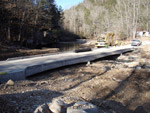
Infrastructure
Bridges for Human and Aquatic Species
The U.S. Forest Service is renovating its bridges from the bottom up to ensure safe passage for both human and aquatic life.
The U.S. Forest Service is monitoring bridges throughout the 193 millions acres of National Forest lands to determine their condition and their impact on human traffic and aquatic life.
Under a government contract, MACTEC Engineering and Consulting, Inc assembled a design team to work on problems in nine national forests. The firm evaluated the risks and determined mitigating measures for stream crossings. While each site presented unique conditions, all of them required structural engineering and hydrologic and hydrology studies.
USFS engineers identified four low-water crossing projects, three single-span bridges and four multi-span bridges that needed improvement. Here's a description of the work performed at four of these sites.
Barkshed Low-Water Crossing, Ark.
This low-water-crossing in the
Ozark-St. Francis National Forest within the Sylamore Ranger District supported very low traffic but provided commercial trucks access to logging tracts. Its aging concrete slabs blocked passage of aquatic species during low-stream flow.
The firm recommended demolishing and removing the structure, which included multiple 1-foot thick concrete slabs forming a 22-foot- by 140-foot-long crossing of North Sylamore Creek. The replacement is a cast-in-place (CIP), reinforced, concrete structure that supports a standard 20-ton truck load.
The CIP structure will:
- Provide passage for threatened fish, a variety of darter, beneath it when low water is flowing,
- Allow sandy gravel streambed sediments to wash downstream beneath it rather than be retained against it, and
- Withstand periodic heavy flooding of up to 15 feet over the crossing.
The foundation design also protected the structure from scour and resisted lateral and uplift forces when water overtops the crossing.
The new crossing cost $270,000 and was completed in January.
Connelly Creek Bridge, N.C.The structure across Connelly Creek in the
Nantahala National Forest in western North Carolina is another old low-water-crossing that is deteriorating. It is a traffic hazard and blocks the free flow of sediments.
 The team designed a 60-foot, single-span bridge, which will allow the 100-year flood event to pass under the girders with adequate clearance. Because the bridge will span the creek bed, aquatic life will experience minimal disturbance and sediments will not build up.
The team designed a 60-foot, single-span bridge, which will allow the 100-year flood event to pass under the girders with adequate clearance. Because the bridge will span the creek bed, aquatic life will experience minimal disturbance and sediments will not build up.
USFS considered a new bridge with pre-stressed concrete cored slab girders at a cost up to $395,000 and a prefabricated steel truss at a cost up to $440,000. To meet criteria of the American Association of State Highway and Transportation Officials Load and Resistance Factor Design, the bridge must support a standard truck weighing approximately 36 tons. Workers will install W-beam guardrails that have passed a crash test for safety. The agency selected the cored slab girder design, which is scheduled for construction this summer.
Juniper Creek Bridge, Fla.This 160-foot long, five-span pre-stressed concrete box beam bridge was built in 1963 and is located in the
Apalachicola National Forest in Florida on FSR 125. The superstructure consists of a reinforced concrete slab and a substructure with bents composed of concrete caps, each supported on four wooden, 12-inch diameter piles.
After its 2006 inspection, the bridge earned a condition rating of 3 or in "serious condition." The wooden piles are severely decayed and settling can be seen along the deck sections. The bridge is potentially unsafe for fire trucks, logging trucks and other large truck traffic. Because this bridge represents the only fire or commercial access to parts of the forest, it is a high priority for replacement.
The team considered a five-span or a four-span 160-foot long bridge. The five-span design would have precast 34-foot-long concrete T-beams and could carry a standard semi-trailer truck weighing 36 tons. New caps would be cast on concrete piles and a precast concrete panel wall would be installed behind the abutment piles to retain the soil. Total cost was estimated at about $272,000. The four-span option would have precast 40-foot long T-beams. It was estimated to cost about $268,000.
The difference in the designs is that the five-span option avoided the low-flow center channel while the four-span alternative placed a supporting pile bent within the low-flow channel. Because this site exhibits very low gradients and produces very slow flow rates, the USFS chose the four-span design.
Wolf Creek Bridge, Tenn.The three-span steel and wood deck structure in the Ocoee/Hiwassee Ranger District of the
Cherokee National Forest in Polk County, Tenn., has a 79-foot centerline distance across the bridge. The approach roads on both sides of the bridge are essentially “S” curves that inhibit line-of-sight and can be a challenge for the log trucks that frequently use the roadway. The Forest Service initially wanted to replace the bridge to straighten the road and provide a clear, single span crossing over the creek. The bridge already allowed free flow during design storm events.
Upon evaluating various alternatives, the design team discovered that the existing supporting substructure was sound. MACTEC engineers analyzed bridge foundation and deck slab plans and details and tested the foundation and steel structures, concluding that concrete replacement of the wood deck would meet USFS' needs.
Because the structure did not jeopardize human safety or affect fish passage, the agency selected the deck replacement.
The guiding principal in these locations was ensuring human safety and protecting aquatic life. All of the projects include erosion and runoff control measures, protection of sensitive waterways and threatened species, and improvements for commercial and emergency transportation.
About the Author
Roy Moore is senior principal engineer for MACTEC and is based in the firm's Atlanta office.